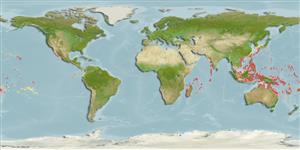Common names from other countries
>
Gobiiformes (Gobies) >
Gobiidae (Gobies) > Gobiinae
Etymology: Eviota: No etymology given, suggested by Christopher Scharpt: from Latin 'eu' for 'true' and 'iota' for anything very small, in combination 'truly very small' referring to it as being the smallest vertebrate at the time it has benn described by Jenkins (thus, making the suggestion by Scharpt plausible..
More on author: Smith.
Environment: milieu / climate zone / depth range / distribution range
экология
морской ассоциированный с рифами; пределы глубины 0 - 18 m (Ref. 86942). Tropical
Indo-Pacific: from the East African coast (Mozambique) and Seychelles, Aldabra, and Chagos; the East Indian region; southward to Australia; north to Japan and Micronesia (Palau, Guam, Northern Mariana Islands, Federated States of Micronesia, Marshall Islands, and Kiribati [Line Islands]), and east to French Polynesia (Society Islands).
Size / Вес / Возраст
Maturity: Lm ? range ? - ? cm
Max length : 1.9 cm SL самец/пол неопределен; (Ref. 1602)
Краткое описание
определительные ключи | морфология | морфометрия
колючие лучи спинного плавника (общее число) : 7; членистые (мягкие) лучи спинного плавника (общее число) : 8; колючие лучи анального плавника: 1; членистые (мягкие) лучи анального плавника: 8 - 9. Characterized by semi-transparent, greenish-brown body with about six faint, internal dark bars; scale margins narrow orange-brown; short brown bars across top of head and along upper back; presence of dark internal blotches above anal fin and lower edge of caudal peduncle; upper portion of caudal peduncle with large black spot; eleventh to fifteenth pectoral rays usually branched; ctenoid scales, absent on head, nape and pectoral fin base; longitudinal scale series 23-24; separated pelvic fins, thin membrane joining bases; rudimentary fifth pelvic ray; average of 6-7 branches on fourth pelvic ray; depth of body 3.6-4.2 in SL (Ref. 90102). Dorsal to anal fin-ray formula 8/8.
Inhabits shallow coral reefs to about 10 m (Ref 90102).
Life cycle and mating behavior
Maturities | размножение | Spawnings | Egg(s) | Fecundities | личинки
Myers, R.F., 1991. Micronesian reef fishes. Second Ed. Coral Graphics, Barrigada, Guam. 298 p. (Ref. 1602)
Статус Красного Списка МСОП (Ref. 130435)
CITES (Ref. 128078)
Not Evaluated
Угроза для людей
Harmless
Использование человеком
дополнительная информация
инструменты
Специальные отчеты
Скачать в формате XML
ресурсы в Интернет
Estimates based on models
Preferred temperature (Ref.
115969): 24.7 - 29.3, mean 28.2 (based on 2315 cells).
Phylogenetic diversity index (Ref.
82804): PD
50 = 0.5000 [Uniqueness, from 0.5 = low to 2.0 = high].
Bayesian length-weight: a=0.00708 (0.00333 - 0.01504), b=3.09 (2.92 - 3.26), in cm Total Length, based on LWR estimates for this (Sub)family-body shape (Ref.
93245).
Trophic level (Ref.
69278): 3.0 ±0.3 se; based on size and trophs of closest relatives
устойчивость к внешним воздействиям (Ref.
120179): высокий, минимальное время удвоения популяции до 15 месяцев (Preliminary K or Fecundity.).
Fishing Vulnerability (Ref.
59153): Low vulnerability (10 of 100).
